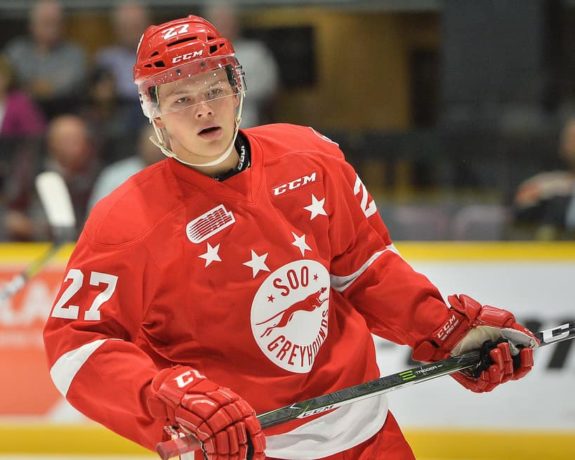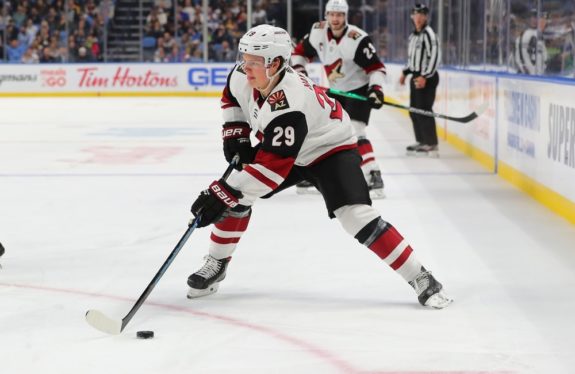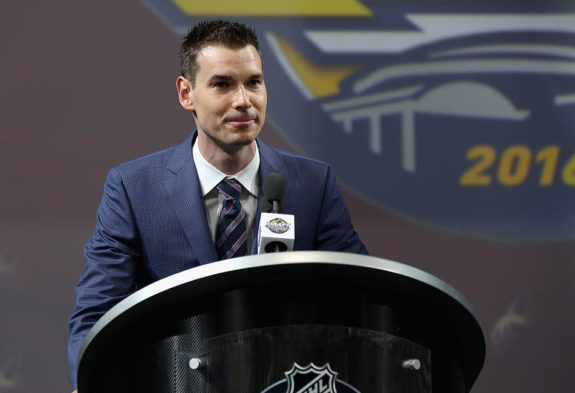By now, it’s likely that both the Arizona Coyotes organization and its fans are very familiar with the restrictions of the Canadian Hockey League/National Hockey League (CHL/NHL) transfer agreement.
You know, the rule that meant players like Max Domi, Dylan Strome, and others had to go back to their junior clubs even though they clearly were ready to step up and begin their professional careers in the American Hockey League? That’s the result of the CHL/NHL transfer agreement.

According to the agreement, NHL prospects in their age-18 or age-19 seasons that have been drafted from Canadian major-junior clubs are not eligible for AHL competition until their junior club’s season has been completed.
The transfer agreement encompasses a large number of players every year – the CHL, which consists of the 20-team Ontario Hockey League (OHL), the 22-team Western Hockey League (WHL), and the 18-team Quebec Major Junior Hockey League (QMJHL), produced 28 of the 62 players selected in the first and second rounds of the 2019 draft.
Why the Rule?
The reasons for this transfer agreement are many – if every major-junior prospect was eligible for play in the AHL upon turning 18, it’s probable that most high-end players would elect to begin their professional careers immediately after being drafted. As a result, the level of competition in the CHL would decrease, and major-junior teams might see drops in attendance and revenue as a result. The major-junior product, comprised of the OHL, WHL, and QMJHL regular seasons, playoffs, and Memorial Cup, as well as the World Junior Championships, would suffer due to the drop-off in talent.

The AHL itself has no age limit – anyone aged 18 or older can play in the league. The age restriction for major-junior prospects is borne solely out of the CHL’s desire to protect its product. For the most part, it works – the vast majority of 18 and 19-year-old major-junior players aren’t ready to make the jump to professional hockey, and the extra two years of CHL hockey are a better development route than playing (and likely struggling) against grown men in the AHL.
For some players, though, the CHL/NHL transfer agreement is a hindrance. If a prospect has just come off of a dominating major-junior season but can’t quite crack his NHL club’s roster to start the year, he’s forced to either sit in the press box as a regular healthy scratch with limited ice time, or go back to the CHL for another year, where he likely has nothing left to prove and can’t benefit from the tutelage of his professional club’s coaching staff and teammates.
We previously mentioned players like Strome and Domi who were affected by this rule. In Domi’s case, he posted 93 points in 61 games in 2013-14, but was one of the last players cut from Arizona’s training camp in 2014-15. He returned to the OHL’s London Knights and posted 102 points in 57 regular-season games while playing with Mitch Marner and Christian Dvorak.

Had he been playing AHL hockey with the organization, Domi likely would have earned a late-season call-up to the dreadful 2014-15 Coyotes squad which won just 24 games. Instead, then-general manager Don Maloney resorted to using forwards like B.J. Crombeen, Tye McGinn, Brandon McMillan, and Dave Moss in regular roles down the stretch. Surely, Maloney could have found a spot in the lineup for Domi had he been available.
For Strome, he dominated the OHL with 129 points in 68 games in 2015-16, but clearly wasn’t ready for the NHL as a 19-year-old in 2016-17. He started the year with the Coyotes, but lasted just seven games before being optioned back to the Erie Otters. There, he was barely challenged, posting 75 points in 35 regular-season games, 34 points in 22 playoff contests, and 11 points in 5 Memorial Cup games.

Both players likely would have benefitted immensely from starting the year with the Coyotes’ AHL affiliate with the chance to be promoted to the NHL later in the season based on their play, but the option was unavailable due to the transfer agreement.
Ultimately, both players are no longer in the Coyotes organization – Domi was traded to the Montreal Canadiens for Alex Galchenyuk on June 16, 2018, after regressing following a stellar rookie season, while Strome never developed into a reliable NHL player during his time in the desert and was sent to the Chicago Blackhawks on Nov. 25, 2018, in exchange for Nick Schmaltz. One has to wonder how differently the Coyotes’ careers of Strome and Domi would have unfolded had they been developing in the organization as 19-year-olds.
The Barrett Hayton Question
One player who has been impacted by the transfer agreement in the present day is Arizona’s 2018 first-round pick, Barrett Hayton. Like Strome and Domi, Hayton posted a massively successful age-18 campaign in junior hockey, with 66 points across 39 regular-season contests and 16 points in 11 playoff games. Like Strome and Domi, Hayton has nothing left to prove in junior hockey, but is unable to play in the AHL.
Instead of sending him back to the Sault Ste. Marie Greyhounds for another season in the OHL, the Coyotes elected to keep Hayton on the NHL roster. His Coyotes career began on a promising note, as he recorded four points in his first six games in Arizona. Since then, though, he’s seemingly hit a wall – he endured an eight-game pointless streak from Nov. 4 to Nov. 29, whereupon he was loaned to Hockey Canada for the 2020 World Junior Championship.

As Captain Canada, Hayton dominated the tournament – he posted 6 goals and 6 assists in 7 games and notably scored a late game-tying goal in the gold medal game against Russia just one day after suffering a separated shoulder in the semifinals against Finland. Hayton then missed a month as he recovered from the injury, and enjoyed a successful five-game AHL conditioning stint before returning to the Coyotes.
However, since rejoining the NHL club, Hayton’s struggles have resumed. His pointless streak is now at 14 games after the Coyotes’ loss to the Calgary Flames on Friday night, and the 19-year-old played just 5:56 in that contest, including only two shifts encompassing a total of 1:28 over the game’s final 32 minutes.
With the Western Conference playoff race tightening by the day and points being at a premium, it might behoove head coach Rick Tocchet to replace Hayton in the lineup with either Christian Fischer or Michael Grabner, who both have the ability to record points in the NHL while also contributing in the defensive zone.
Is Hayton Better Off in the AHL?
As we previously discussed, players who are sent back to their junior teams as 18 or 19-year-olds are eligible to return to their NHL organization once their junior season has concluded. In years past, both Strome and Domi experienced considerable individual and team success upon their return to the OHL. As a result, neither completed play with their junior team prior to the completion of the NHL or AHL seasons, and, therefore, they did not return to the Coyotes organization until the following year.
In Hayton’s case, the Greyhounds have struggled mightily in 2019-20 without him on the roster. At the end of play on Friday, the club found themselves in ninth place in the Western Conference standings, three points back of the eighth-place Erie Otters with one more game played. Only the top eight teams in each conference qualify for the J. Ross Robertson Cup Playoffs, so there’s a chance that Sault Ste. Marie’s season will end when their final regular-season game is played on March 22.

Here’s where the restrictions of the CHL/NHL transfer agreement start to subside. If the Greyhounds do not qualify for the playoffs, Hayton will become eligible to play in the AHL on March 23. At that point, the Coyotes will have just six regular-season games remaining. If they’re still in playoff contention, and Hayton is still struggling, they need to send him down to the Tucson Roadrunners for further development.
The benefits of such a move are numerous. For Hayton, he’d have the chance to play meaningful top-six minutes and earn valuable postseason experience with the Calder Cup-contending Roadrunners instead of playing six minutes a night in the NHL. For the Coyotes, they’d be able to insert either Grabner or Fischer into the lineup for the stretch run. Goals have been hard to come by for the club this season, and both players have shown an ability to get on the scoresheet, with 14 combined goals this season.
The CHL/NHL transfer agreement generally does not work in NHL teams’ favor when it comes to optioning prospects to the AHL, but there’s an opening here for Barrett Hayton to play in the AHL as a 19-year-old. The Coyotes need to take advantage of this opportunity and get Hayton the top-six AHL minutes he needs while also getting a veteran back in the lineup for the stretch run.